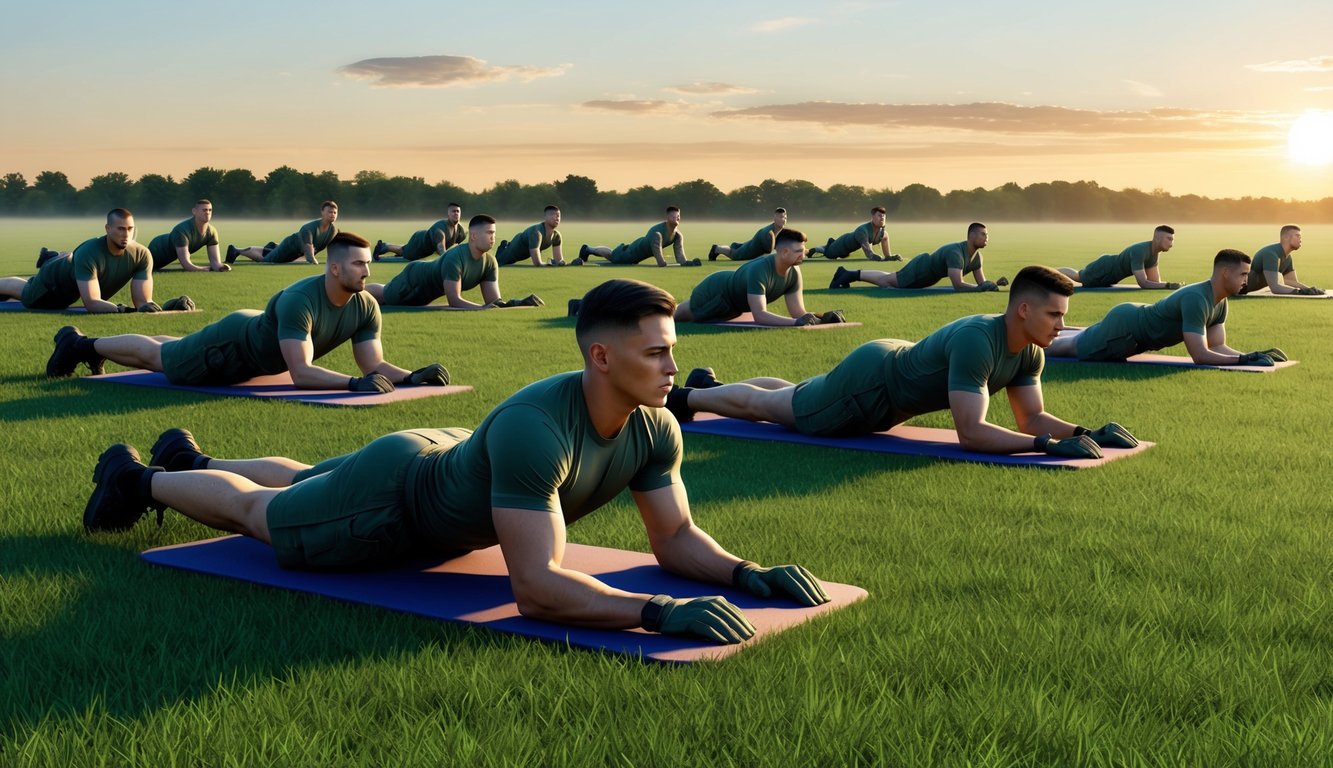Army Physical Readiness Training (PRT) plays a vital role in military fitness, equipping soldiers for the strenuous physical demands they may encounter in combat.
The PRT program emphasizes the enhancement of strength, endurance, and mobility through a carefully structured array of exercises and drills.
This holistic method not only boosts your physical abilities but also fosters your mental toughness and overall preparedness for serving in the military.
PRT sessions are typically divided into three phases: preparation, activity, and recovery.
The preparation phase warms up your muscles and joints, priming your body for more intense activities.
During the activity phase, you’ll participate in exercises targeting critical fitness aspects such as strength, endurance, and flexibility.
The recovery phase focuses on cooling down your body, helping to prevent injuries.
Key Takeaways
- Army PRT develops strength, endurance, and mobility for combat readiness
- PRT sessions include preparation, activity, and recovery phases
- The program enhances both physical and mental resilience for military service
Fundamentals of Army PRT
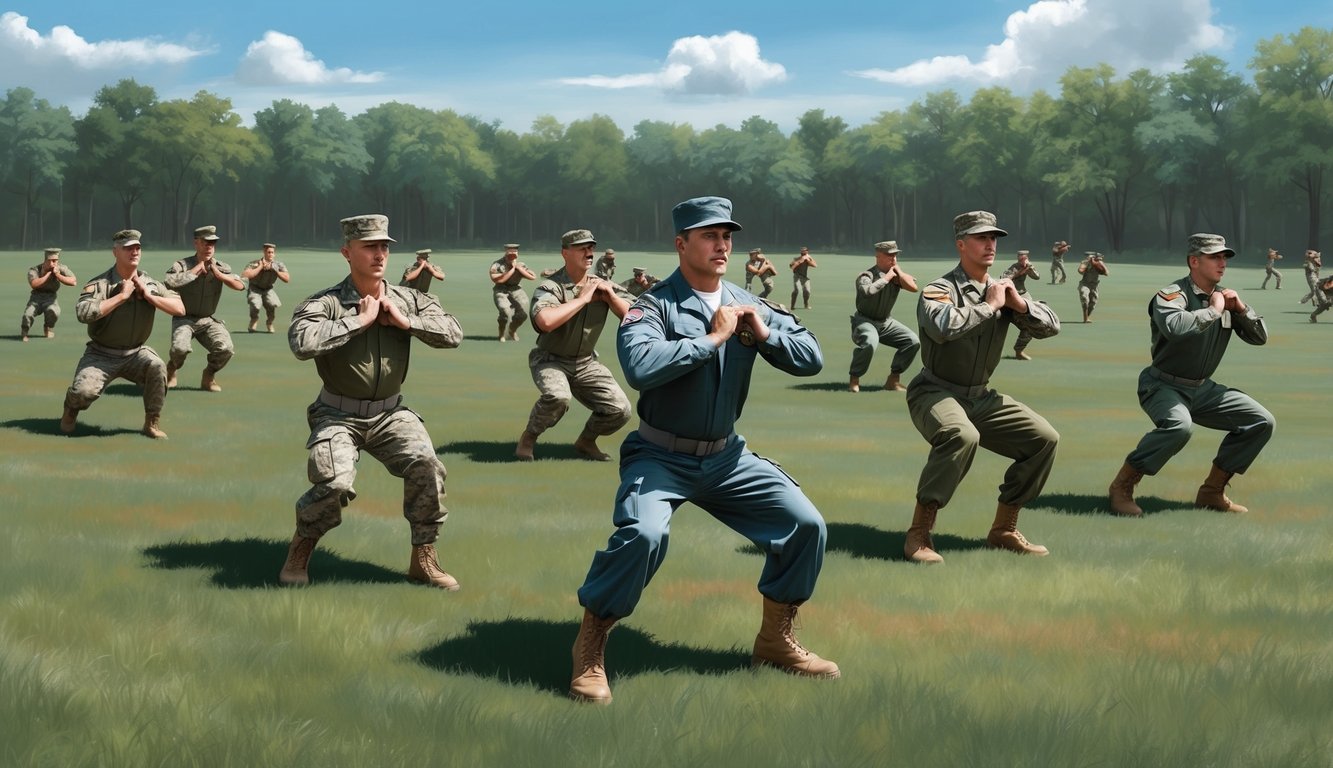
Physical Readiness Training (PRT) serves as the foundation of Army fitness, preparing soldiers to meet the considerable demands of combat and military service.
Physical Readiness Defined
Physical readiness is the capacity to face the physical challenges associated with military duties, encompassing strength, endurance, and mobility.
These components synergize to ensure effectiveness in any situation.
The aim of PRT is to enhance your overall physical capacity, emphasizing improvement in cardiovascular endurance, muscular strength, and flexibility.
A focus on these areas will better prepare you for the physical demands of combat.
Moreover, the Army’s approach integrates proper nutrition and rest, facilitating maximum performance potential.
Importance of Physical Readiness
Physical readiness is essential for a soldier’s success, directly influencing the ability to execute missions and endure combat scenarios.
Being physically prepared lowers the risk of injuries during both training and deployment.
A fit soldier is less prone to muscle strains or fatigue-related incidents.
In high-stakes combat situations, physical readiness can be life-saving, allowing for swift movements, heavy load carrying, and functioning under extreme pressure.
Additionally, PRT strengthens mental resilience.
Pushing physical limits cultivates greater mental toughness, enabling focus and sound decision-making under stress.
Key Components of Army PRT
Army Physical Readiness Training (PRT) is designed to prepare soldiers to meet the physical challenges of military operations.
The program prioritizes the development of strength, endurance, and mobility to enhance overall combat readiness.
Strength and Resilience
Strength training is fundamental in Army PRT, comprising exercises focused on enhancing muscular power and resilience, including push-ups, pull-ups, and targeted weightlifting routines.
Bodyweight exercises are foundational to your strength training, being practical and adaptable for any environment, including field conditions.
Incorporating resistance training with equipment like kettlebells and medicine balls diversifies workouts, helping to avoid plateaus and continually challenge muscles.
By emphasizing functional strength, you’ll gain the power necessary for tasks such as carrying heavy equipment or navigating obstacles, directly improving your performance in combat settings.
Endurance and Stamina
Cardiovascular fitness is vital for soldiers, and you’ll engage in various activities aimed at building endurance and stamina vital for long missions and intense combat conditions.
Running is a critical aspect of endurance training, with both distance runs to enhance aerobic capacity and sprint intervals to boost anaerobic performance included.
Ruck marches simulate the carrying of heavy loads over extended distances, mirroring common military tasks.
Low-impact alternatives like swimming and cycling may also be incorporated, providing excellent cardiovascular benefits while lessening stress on joints.
By enhancing endurance, you’ll be better prepared to handle both the physical and mental demands of extended military operations.
Mobility and Flexibility
Mobility and flexibility training is crucial for preventing injuries and enhancing overall physical performance.
You’ll learn exercises that promote improved body control and range of motion.
Dynamic stretching routines performed pre-workout prepare muscles and joints, including movements such as leg swings, arm circles, and torso twists.
Yoga-inspired poses can enhance balance and core strength while increasing flexibility, valuable skills for maneuvering in challenging terrains or tight spaces.
Agility drills, including ladder exercises and cone drills, refine coordination and reflexes, contributing to improved performance in combat scenarios where prompt, precise actions are essential.
Regular mobility work aids in maintaining flexibility as you build strength and endurance, establishing a well-rounded physical foundation for military service.
Phases of Army PRT
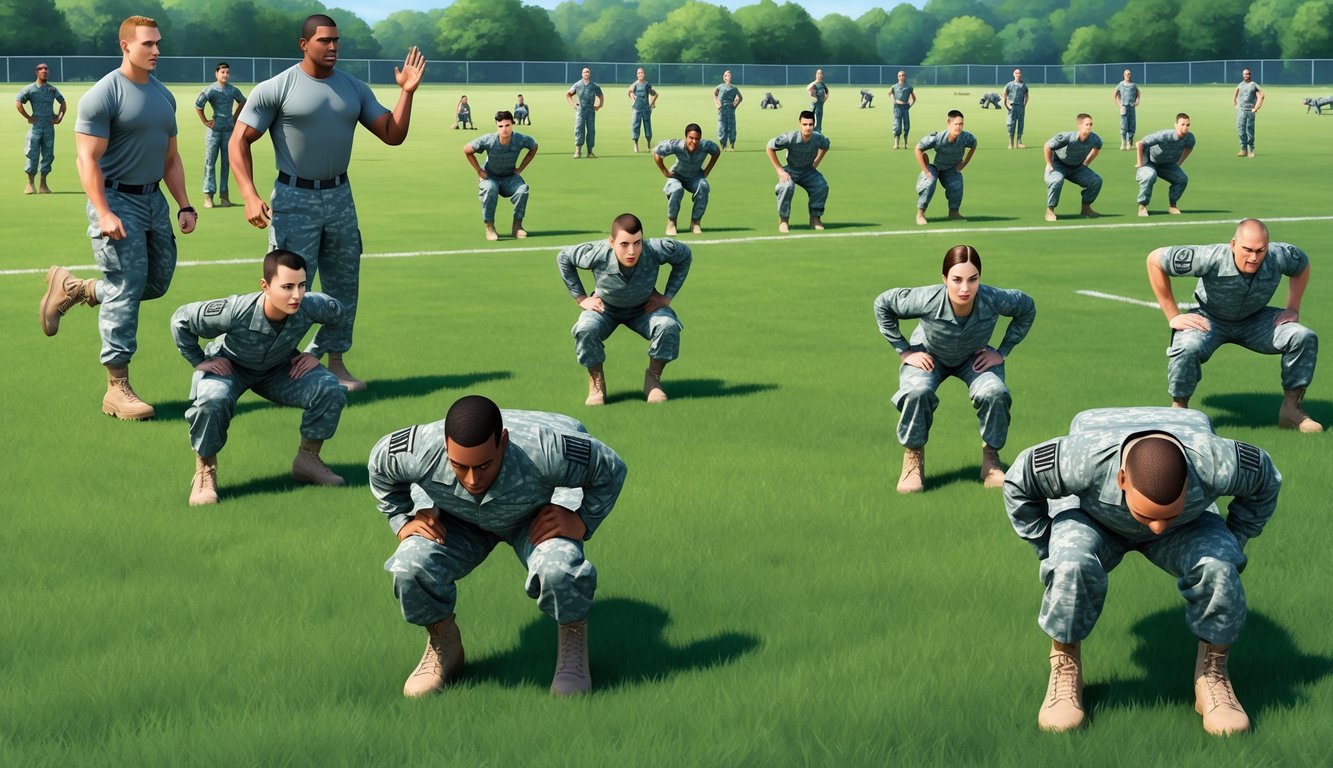
Army Physical Readiness Training (PRT) is structured into distinct phases that gradually build soldiers’ strength, endurance, and overall fitness, with each phase designed for specific developmental purposes.
Initial Conditioning Phase
This phase serves as the foundation for your military fitness journey, particularly tailored for future soldiers in programs like the Army’s Future Soldier Program and ROTC.
It focuses on fundamental exercises and principles that prepare your body for the challenges ahead.
During this phase, you will learn proper exercise form for fundamental movements like push-ups, sit-ups, and running, aimed at cementing a solid fitness base before proceeding to Basic Combat Training (BCT).
Typically, this phase lasts from a few weeks to a few months, depending on your initial fitness level.
Key activities include:
- Introduction to Army PRT exercises
- Gradual increase in workout intensity
- Focus on injury prevention and proper technique
Toughening Phase
Once you commence BCT or the early stages of One Station Unit Training (OSUT), you’ll enter the toughening phase, characterized by an uptick in intensity.
You’ll adhere to a structured daily PRT schedule designed to push your limits and enhance both physical and mental toughness.
This toughening phase generally features:
- Preparation drills (PD)
- Movement drills (MD)
- Strength and mobility exercises
- Endurance and mobility activities
A typical weekly schedule might resemble the following:
| Day | Activities |
|---|---|
| Mon | Preparation Drills, Hip Stability Drill, Military Movement Drill 1 |
| Tue | 4 for the Core, Conditioning Drill 1, Climbing Drill 1 |
| Wed | Preparation Drills, 4 for the Core, Ability Group Run |
| Thu | Conditioning Drill 1, Push-up and Sit-up Drill |
| Fri | Preparation Drills, Military Movement Drill 1, Foot March |
Sustaining Phase
Following the completion of initial military training, you’ll transition to the sustaining phase aimed at preserving and enhancing the fitness levels achieved previously.
This phase is more flexible than the toughening phase, allowing for diverse activities and schedules.
During the sustaining phase, you will typically engage in PRT four to five days a week.
Workouts will include a balanced mix of:
- Strength training
- Endurance activities
- Mobility exercises
- Functional fitness drills
Variety is key here; sessions may include weight training one day, a ruck march the next, and a swim session later in the week, ensuring your body remains challenged while mitigating boredom.
Reconditioning
The reconditioning phase is crucial for soldiers recovering from injuries or extended inactivity.
This phase entails a gradual return to full PRT participation, placing emphasis on safe and progressive training.
If you are navigating the reconditioning phase, you will collaborate closely with medical professionals and your unit’s fitness leaders to devise a personalized plan aimed at regaining strength and endurance without risking re-injury.
Your reconditioning program may include:
- Low-impact cardio (e.g., swimming, cycling)
- Modified strength exercises
- Flexibility and mobility work
- Gradual intensity and duration increases
The objective is to facilitate a safe and swift return to full duty, with patience being paramount.
Rushing recovery can lead to setbacks.
Army PRT Exercises
Army Physical Readiness Training (PRT) exercises are integral to soldier fitness, built to improve strength, endurance, and mobility while minimizing injury risk.
Let’s delve into the key components of the Army PRT program.
Preparation Drill
The Preparation Drill serves to warm up your body, getting you ready for more intense activities.
This drill involves ten exercises performed sequentially:
- Bend and Reach
- Rear Lunge
- High Jumper
- Rower
- Squat Bender
These movements engage major muscle groups and joints.
Each exercise is performed for 5 to 10 repetitions at a slow, controlled pace, facilitating focus on proper form and gradual range of motion improvement.
The Preparation Drill also incorporates exercises such as the Windmill, Forward Lunge, and Prone Row, all designed to enhance flexibility and core strength.
By the conclusion of the drill, you should feel loose and ready for the main workout.
Recovery Drill
The Recovery Drill aids in cooling down your body after rigorous exercise, crucial for preventing injuries and alleviating muscle soreness.
Notable exercises include:
- Overhead Arm Pull
- Rear Lunge
- Extend and Flex
Each position should be held for 20-30 seconds, emphasizing relaxation and deep breathing.
The Recovery Drill also incorporates stretches for hip flexors, hamstrings, and lower back areas.
The aim is to gradually reduce your heart rate and enhance flexibility.
Regular performance of the Recovery Drill can elevate overall mobility and diminish the risk of future injuries.
Climbing Drills
Climbing Drills strengthen the upper body and core while enhancing the capability to maneuver over obstacles.
The two primary forms are:
- Climbing Drill 1: Focused on pull-ups and leg tucks
- Climbing Drill 2: Involves advanced movements like the Alternating Grip Pull-up
These exercises are typically performed in sets of 5-10 repetitions.
If full pull-ups are a challenge, start with assisted pull-ups or flexed-arm hangs to build the necessary strength.
Climbing Drills also aim to boost your grip strength, essential for numerous military tasks.
Regular practice will enhance performance in both exercises and real-world applications.
Strength Training Circuits
Strength Training Circuits in Army PRT combine bodyweight and equipment-based movements.
A standard circuit could include:
- Push-ups
- Sit-ups
- Pull-ups
- Kettlebell swings
Transitioning quickly from one exercise to the next with minimal rest, you’ll complete 2-3 rounds of the circuit, fostering muscular endurance alongside cardiovascular fitness.
Push-ups represent a cornerstone of Army PRT, primarily targeting your chest, shoulders, and triceps.
Other exercises you’ll encounter include the Supine Bicycle for core training and the Bent-leg Body Twist for oblique strength.
Operational Aspects of Army PRT
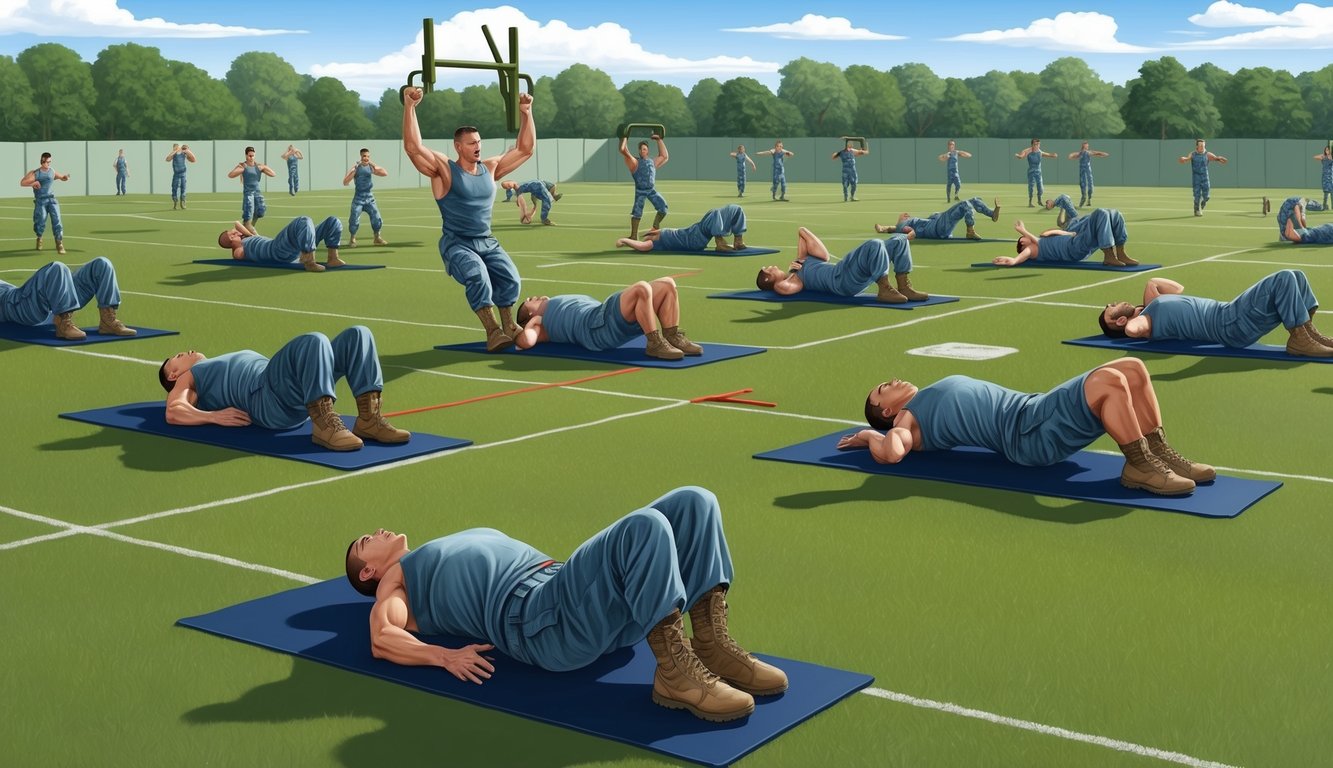
The successful execution of Army Physical Readiness Training (PRT) relies heavily on effective leadership and adequate facilities.
Leaders and drill sergeants play a pivotal role in implementing and overseeing PRT programs, while the training environments significantly influence the quality and efficacy of workouts.
Role of Leaders and Drill Sergeants
Leaders and drill sergeants form the backbone of Army PRT, tasked with planning, executing, and evaluating training sessions.
They set the unit’s fitness culture, ensuring alignment of PRT with mission objectives.
Drill sergeants manage daily PRT sessions, demonstrating proper forms and motivating participants to push their boundaries.
They closely monitor progress, offering feedback to foster improvement.
Instructors at the U.S. Army Physical Fitness School train future leaders in current PRT techniques, ensuring consistent, high-quality instruction across diverse units.
Training Environments and Facilities
Your PRT experience varies based on your setting and the facilities available.
For example, Fort Jackson features cutting-edge training grounds designed specifically for PRT exercises.
Many installations provide dedicated PRT areas equipped with resources like pull-up bars, climbing ropes, and obstacle courses.
Training will also utilize open fields, running tracks, and weight rooms for various activities.
In austere environments, leaders creatively adapt PRT using accessible resources, sometimes leveraging natural terrain or improvised equipment to maintain fitness standards.
Indoor facilities become indispensable during adverse conditions, enabling uninterrupted training regardless of weather patterns.
PRT Session Elements
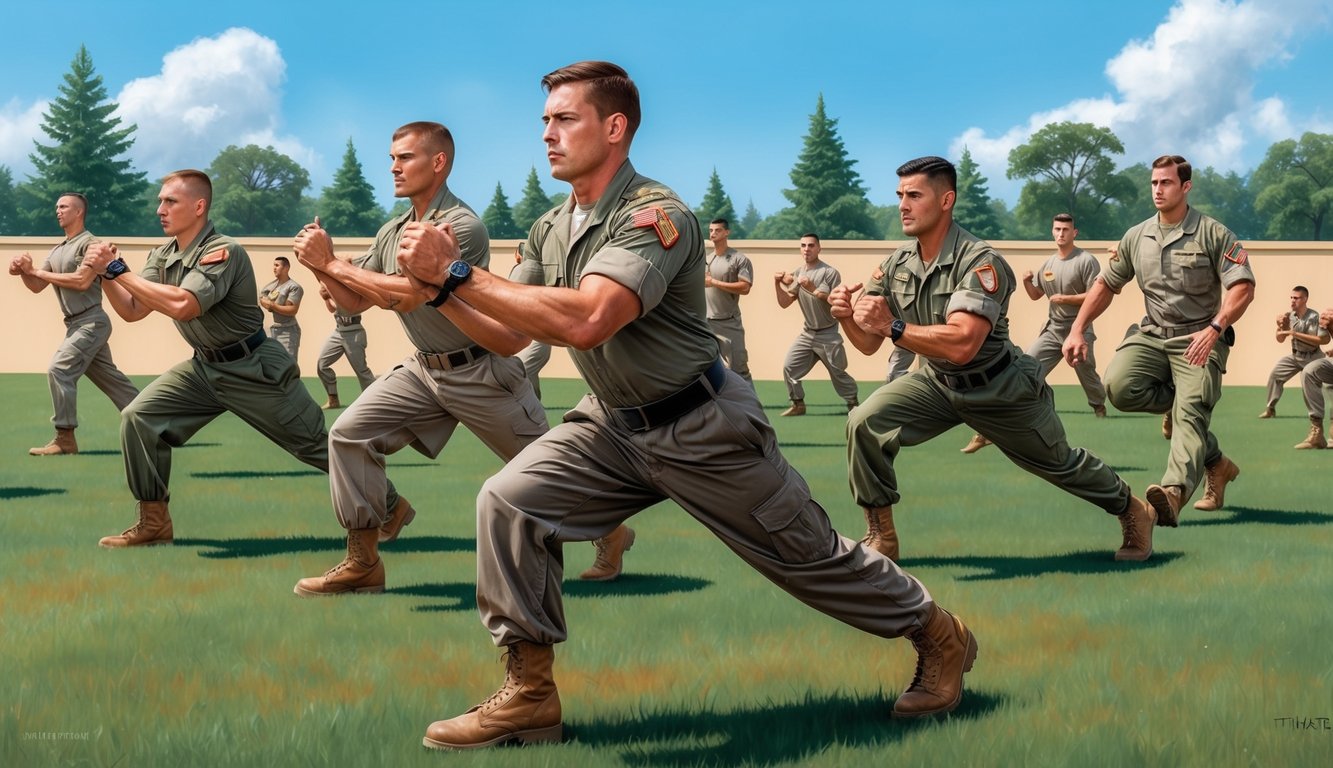
Army Physical Readiness Training (PRT) sessions are structured to optimize fitness gains while minimizing injury risks.
Each session generally includes warm-up protocols, core training activities, and cooldown practices, each crucial for preparing soldiers for the physical demands of military service.
Warm-Up Routines
Your PRT session commences with dynamic warm-up exercises.
The preparation drill (PD) is a significant part, consisting of ten exercises aimed at enhancing heart rate and loosening muscles.
Exercises include:
- Bend and reach
- Rear lunge
- High jumper
- Rower
- Squat bender
Performing each exercise for 5-10 repetitions helps avert injuries and readies your body for heightened activity.
Maintain proper technique and adhere to the pace set by your instructor during this stage.
Core Training Activities
The main body of your PRT session focuses on building strength, endurance, and agility through a range of military-specific exercises.
Key activities may include:
- Push-ups and sit-ups for upper body and core strength
- Shuttle runs to enhance speed and agility
- Climbing drills to bolster upper body and grip strength
- Guerrilla drills for comprehensive conditioning
Your instructor will guide these exercises, ensuring you maintain the correct form and intensity.
It’s important to stay hydrated and listen to your body’s signals throughout these demanding activities.
Cooldown Procedures
Following the demanding core activities, transition into cooldown exercises to facilitate gradual heart rate reduction and mitigate muscle soreness.
Typical cooldown procedures incorporate:
- Light jogging or walking
- Static stretching exercises
- Deep breathing exercises
Hold each stretch for 20-30 seconds without bouncing; the cooldown phase aids in recovery and prepares you for subsequent daily tasks.
Do not overlook this phase, as it reduces injury risks and enhances overall flexibility.
Planning and Conducting PRT
Effective Physical Readiness Training (PRT) hinges on meticulous planning and execution.
Proper scheduling, frequency, and risk management are critical for developing capable soldiers while promoting health and preparedness.
PRT Scheduling and Frequency
PRT sessions should occur four to five days weekly, as outlined in AR 350-1.
This frequency fosters consistency and allows for adequate recovery between workouts.
When crafting your unit’s PRT schedule, keep in mind:
• Alternate strength, endurance, and mobility exercises
• Incorporate both individual and group activities
• Organize sessions during non-conflicting time slots with other responsibilities
Ensure that activities were varied weekly within the sustaining phase to promote diverse training while meeting your unit’s physical requirements.
Risk Management and Safety
Prioritizing soldier safety is paramount during PRT.
Implement the composite risk management process to identify and mitigate potential hazards.
Factors to consider include:
• Participant age and gender
• Environmental conditions (heat, cold, terrain)
• Equipment condition and availability
• Soldiers’ fitness levels and history of injuries
Before each exercise, brief soldiers on correct technique, encouraging them to voice any pain or discomfort.
Always have a contingency plan for medical emergencies, ensuring access to hydration and shade during outdoor sessions.
Evaluating Physical Readiness
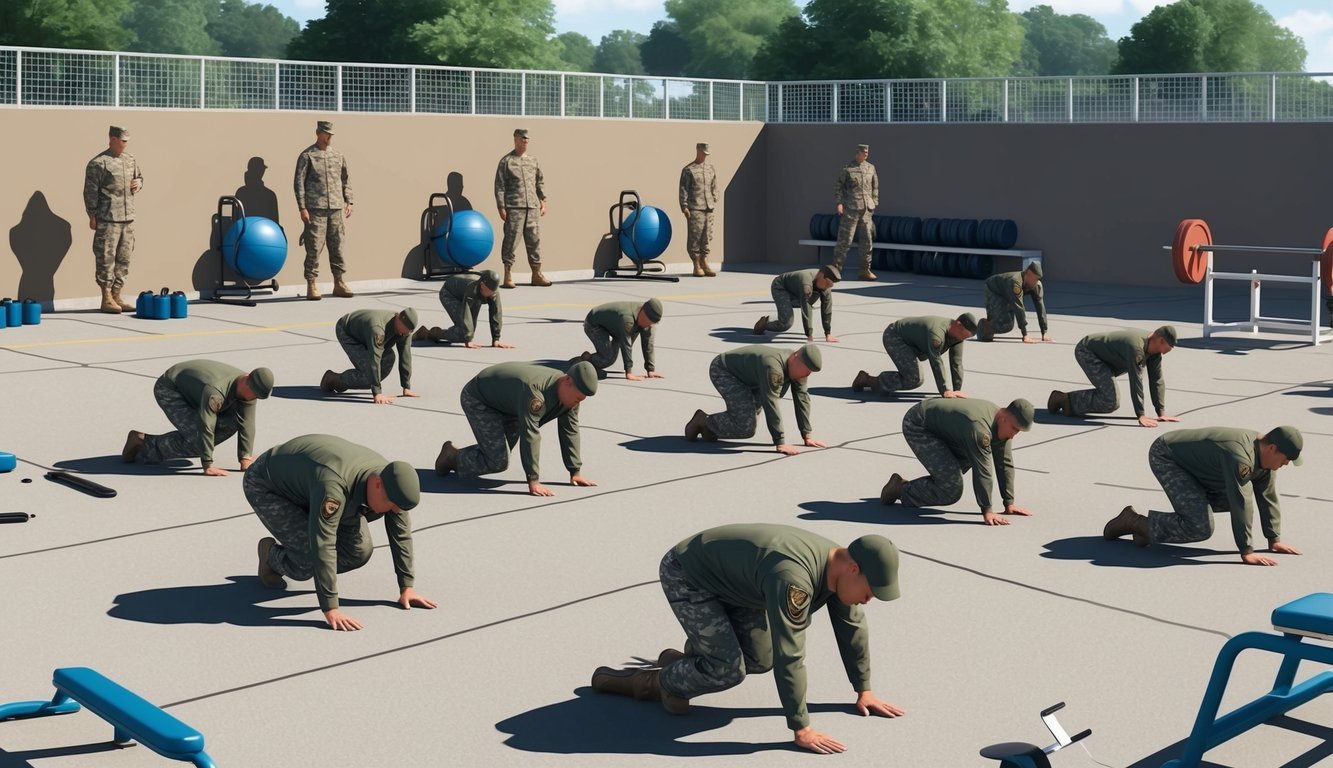
The U.S. Army employs two primary assessments to gauge soldiers’ physical readiness, evaluating disparate fitness aspects and combat readiness.
Army Combat Fitness Test (ACFT)
The ACFT is a newer, more holistic evaluation, comprising six events that reflect combat tasks:
- 3-Repetition Maximum Deadlift
- Standing Power Throw
- Hand-Release Push-Ups
- Sprint-Drag-Carry
- Leg Tuck or Plank
- 2-Mile Run
This comprehensive test evaluates your strength, power, speed, and endurance, requiring preparation for diverse movements and energy systems.
ACFT scores are calculated in a gender-neutral manner, aligning with the Army’s combat readiness goals for all soldiers.
Traditional APFT
The Army Physical Fitness Test (APFT) has been the historical standard, consisting of:
- 2 minutes of push-ups
- 2 minutes of sit-ups
- 2-mile run
Results are assessed based on age and gender categories.
Although less comprehensive than the ACFT, the APFT offers insight into muscular endurance and cardiovascular fitness.
While the APFT is phasing out in favor of the ACFT, it may still be encountered occasionally.
Adequate preparation for both tests will ensure readiness for any Army physical evaluation.
Supplemental PRT Resources
The Army provides a range of resources to enhance your Physical Readiness Training experience, aiming to bolster your knowledge and application of PRT principles.
Digital and Online Resources
The Army PRT app is indispensable for soldiers seeking to optimize their training, available for download on both Google Play Store and Apple App Store.
This app features the official Army logo and offers quick access to exercise demos, workout plans, and tracking tools.
ArmyPRT.com serves as a central hub for PRT-related information, offering detailed exercise descriptions, training schedules, and performance improvement tips, regularly updated with the latest guidance and best practices.
For visual learners, the Army’s YouTube channel hosts a variety of instructional videos on PRT, aiding in perfecting techniques for different exercises.
Guides and References
Training Circular 3-22.20 is your primary manual for comprehensive PRT insights, detailing the Army’s physical readiness doctrine and offering extensive training principle explanations.
The older FM 21-20 manual, though superseded, contains valuable information on physical fitness training and may lend useful traditional approaches as supplementary material.
Many unit supply offices provide pocket guides and quick-reference cards, perfect for quick refreshers on exercise sequences or drills while in the field.
Your unit’s Master Fitness Trainers can supply personalized guidelines and additional resources tailored to your specific needs and fitness aspirations.
Specialized Training Programs

The Army features specialized training programs designed to transform civilians into skilled soldiers, focusing on physical fitness, military skills, and occupational specialties.
Basic Combat Training (BCT) and Advanced Training
BCT marks your initiation into soldiering, offering a rigorous 10-week curriculum that pushes physical limits while instilling basic combat skills, military customs, and Army values.
Post-BCT, you transition to Advanced Individual Training (AIT), where training specifics pertain to your chosen Military Occupational Specialty (MOS), varying in length based on the field.
AIT combines classroom instruction with hands-on practice, maintaining physical training while mastering skills pertinent to your future Army responsibilities.
One Station Unit Training (OSUT)
The OSUT program merges BCT and AIT into a seamless, uninterrupted training experience, designed for combat-oriented roles like Infantry or Armor.
During this training, you will remain at a single location, fostering a deeply immersive experience relevant to your chosen specialty.
Program lengths range typically from 14 to 22 weeks, encompassing intense physical conditioning while imparting advanced combat strategies and specialized equipment operation.
OSUT fosters strong bonds among trainees, mirroring the unit cohesion you’ll experience in future assignments.
Frequently Asked Questions
Army Physical Readiness Training (PRT) encompasses an array of exercises, standards, and resources.
Here are answers to some frequently asked questions regarding PRT components and where to locate essential information.
What types of exercises are included in Army Physical Readiness Training?
Army PRT includes a variety of exercises encompassing strength training, cardio routines, and flexibility drills.
Expect exercises like push-ups, sit-ups, and running alongside specialized movements.
Where can I find a comprehensive guide to the drills involved in Army PRT?
Field Manual 7-22 serves as your primary reference for Army PRT drills, providing detailed instructions and descriptions of each exercise, accessible online via official military sources.
How do I download the official Army PRT mobile application?
The Army PRT app is readily available for both iOS and Android devices.
Search for “Army PRT” in your app store and download it for free, gaining access to workout regimens and exercise demonstrations.
Can you explain the standards that need to be met for Army PRT?
PRT standards are age and gender-specific.
Generally, you’ll need to meet minimum criteria for push-ups, sit-ups, and the two-mile run.
For precise scoring tables and passing thresholds, reference the latest Army guidelines.
What does PRT stand for in the context of military physical training?
PRT stands for Physical Readiness Training, the Army’s comprehensive fitness initiative aimed at enhancing soldiers’ physical proficiency and combat readiness.
Which field manual should I refer to for an in-depth understanding of Army PRT?
Your definitive reference for Army PRT is Field Manual 7-22, which details all aspects of the program, including exercise instructions, training principles, and implementation guidance.

